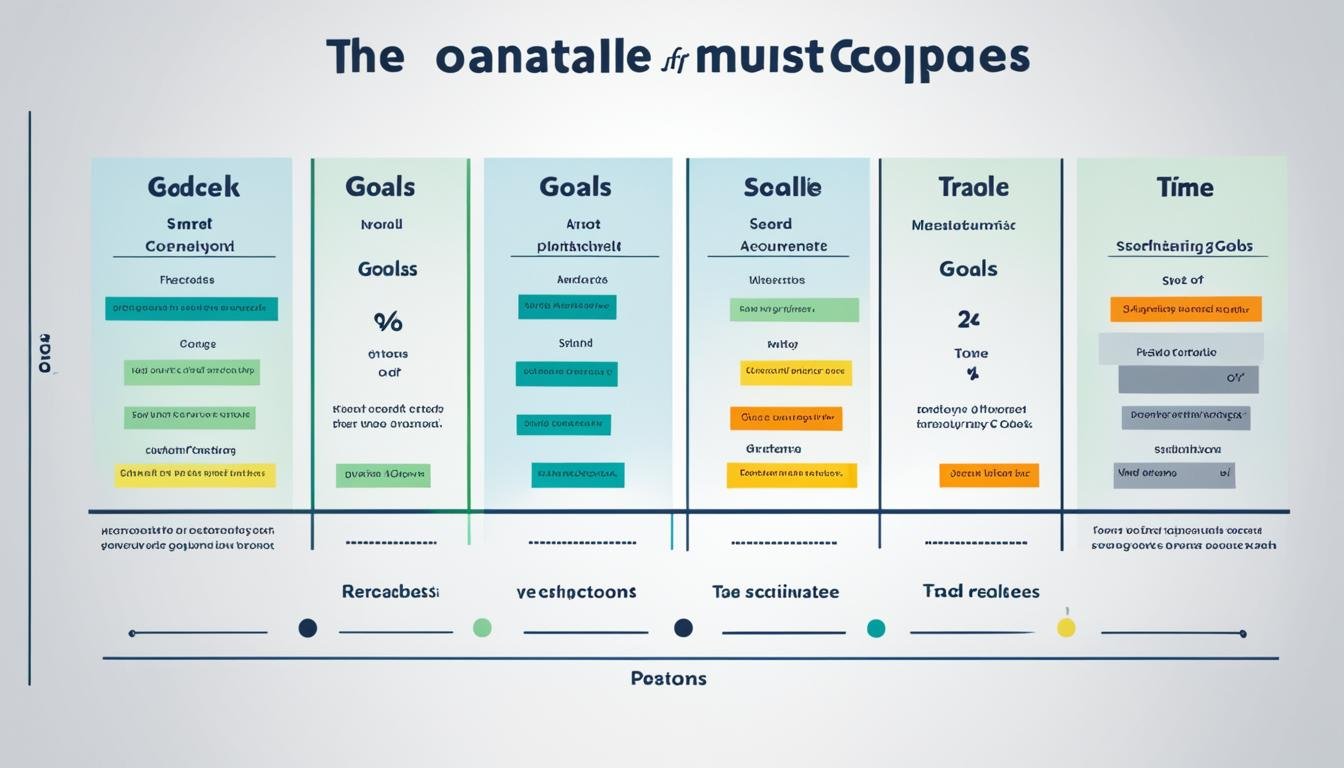Reaching your goals is key to self-motivation and personal growth. But, without a clear plan and strategies, it’s easy to feel lost or give up. That’s where smart goals come in.
Smart goals offer a clear path to success. They are Specific, Measurable, Achievable, Relevant, and Time-bound. This method was first used in business and now helps people in personal development too.
What makes smart goals special is how they make goals clear and easy to track. By setting specific steps, you can take focused actions towards your goals.
Key Takeaways:
- Smart goals provide a structured framework for success and goal achievement, ensuring clarity, measurability, attainability, and relevance.
- By incorporating specific criteria, such as specificity and time-bound nature, smart goals provide a roadmap for success.
- Smart goals originated in the business world and have now become a fundamental principle in personal development strategies.
- Breaking down your goals into actionable steps empowers you to take focused actions and achieve results.
- The acronym SMART stands for Specific, Measurable, Achievable, Relevant, and Time-bound.
The Benefits of Smart Goals
Smart goals offer a strategic way to boost personal and professional success. They help individuals and teams become more productive, focused, and perform better.
- Clarity: Smart goals make it easy to set clear goals. They help people know exactly what they aim to achieve. This clears up confusion and sets a clear path to success.
- Measurability: Unlike vague goals, smart goals can be measured. They include specific criteria and metrics. This lets people track their progress and see how well they’re doing. It also helps them make changes as needed.
- Attainability: Smart goals are set at a level that’s within reach. This keeps people motivated and avoids setting goals that are too hard. It helps prevent feeling overwhelmed.
- Relevance: Smart goals are directly related to the person or team. They match goals with core values and long-term plans. This makes sure efforts are focused and meaningful.
By focusing on these key points, people can use smart goals to grow personally and professionally.
Next, we’ll look at the pros and cons of smart goals. This will give a full view of this approach to setting goals.
Pros and Cons of Smart Goals
Smart goals have many benefits but also some drawbacks. Let’s look at the good and bad sides of using smart goals. This will help you decide if this framework is right for you.
The Pros of Smart Goals
- Clarity: Smart goals make things clear. They help people and teams know exactly what they need to do.
- Measurability: These goals focus on setting targets you can measure. This lets you track your progress and see how well you’re doing.
- Attainability: Smart goals aim for realistic goals. This keeps people motivated and focused on what they want to achieve.
- Relevance: These goals make sure they match up with bigger goals and plans. They help make sure your goals are important and help reach the bigger vision.
The Cons of Smart Goals
- Rigidity: A downside of smart goals is they can be too strict. The need for specific and measurable goals might make it hard to adapt in changing situations.
- Overemphasis on Measurability: Putting too much focus on measuring goals can be a problem. Some goals, like those related to creativity or quality, don’t always fit into a measuring system.
Smart goals have many advantages but aren’t perfect for everyone. It’s important to think about what you or your organization needs before deciding to use them.
Image:

Getting Started with Smart Goals
Starting a smart goals journey has several key steps. These steps help you set up for success and increase your chances of reaching your goals.
Step 1: Identify Objectives
First, define what you want to achieve. Take time to make your goals clear and specific. This gives you a clear focus and direction.
Step 2: Assess Measurability
After setting your objectives, check if they can be measured. Goals that can be measured let you track progress clearly. This makes it easier to see if you’re on the right path.
Step 3: Evaluate Achievability
Setting ambitious goals is good, but they must be achievable. Think about the resources and skills you have. Setting realistic goals helps avoid disappointment and keeps your efforts focused.
Step 4: Relevance Check
Make sure your goals match your main goals and values. Your goals should reflect what’s important to you and help you grow. This ensures your goals have a positive impact on your life.
Step 5: Set a Timeline
Finally, set a timeline for your goals. A timeline adds urgency and structure. It helps you break goals into smaller steps and track your progress.
By following these steps, you create a strong foundation for success. Remember, setting smart goals is ongoing and needs regular checks and adjustments. Stay committed and focused, and your goals can become reality.
| Step | Description |
|---|---|
| Step 1 | Identify Objectives |
| Step 2 | Assess Measurability |
| Step 3 | Evaluate Achievability |
| Step 4 | Relevance Check |
| Step 5 | Set a Timeline |
Sparking Innovation through Slow Down
Slowing down can really help us spark new ideas and boost creativity. When we’re always busy, it’s hard to be creative. But by slowing down and being present, we make room for new ideas to come.
When we slow down, we can see things from a new angle. This lets us notice things we might have missed before. Being in the moment opens up new possibilities and connections that lead to innovation.
Slowing down also helps us clear our minds of distractions. This lets us focus better and be more creative. It’s like cleaning out a cluttered room to make space for new ideas.
Plus, slowing down lets us try new things and take risks. These are key to coming up with new ideas. By going at a slower pace, we’re more open to exploring and trying new things.
“Innovation is a process that requires time, patience, and space for ideas to develop and flourish. By slowing down, we create the necessary conditions for innovation to thrive.” – [Author Name]
Let’s look at how [Company Name] benefited from slowing down. They gave their employees time to relax and think of new ideas. This led to many new projects and happier employees.
By slowing down and being present, we can spark our creativity and encourage innovation. So, take a break, clear your mind, and see what new possibilities you can find.
| Benefits of Slowing Down for Innovation: | How Slowing Down Sparks Innovation: |
|---|---|
|
|
Blueprint for Innovation
When innovation starts, it’s time to have a plan. This plan has seven steps you can follow:
- Evaluate: Look closely at what works in your industry and what’s been done before. This helps spot gaps and chances for new ideas.
- Define: Know what you already know and what you need to learn. This means doing research, collecting data, and finding out what you’re missing.
- Plan: Break your project into smaller goals and steps. This keeps you organized and focused on each part of your innovation.
- Create: Use what you’ve learned to make new content, products, or services. This is where you start making your ideas real.
- Attract: Find people or groups that can help spread the word about your innovation. This could mean making partnerships, marketing, or finding investors.
- Serve: Keep working with your customers and stakeholders as you innovate. Listening to their needs helps you make your idea better.
- Outsource: Find tasks that aren’t crucial and can be given to others. This lets you focus on what’s most important in your innovation.
To really innovate, you must follow these steps carefully. Each one is important for the whole process, from checking the current state to outsourcing. Using this blueprint helps you build a strong base for your creative projects and boosts your chances of success.
Transforming SMART Goals into Actionable Plans
To turn SMART goals into real plans, set clear milestones and break them into specific tasks. Assigning realistic deadlines is key. This approach boosts productivity and helps achieve goals.
Setting milestones is vital for tracking progress and making goals easier to manage. These checkpoints boost motivation and keep the goal in sight. They act as markers, leading you to your goal.
After setting milestones, break them into clear tasks. These tasks should be well-defined and doable. This way, you stay focused and avoid confusion. Each task moves you closer to your goal, making it feel more real and achievable.
Setting realistic deadlines keeps you moving and stops procrastination. Deadlines add urgency and help you make progress in a timely manner. They let you manage your time well, set priorities, and use resources wisely. This approach helps you keep making progress and increases your chances of reaching your goal.
By using milestones, tasks, and deadlines, you can make SMART goals into real plans. This method makes goals clear, focused, and easy to follow. It turns vague goals into clear steps, giving you direction and focus on your way to success.

The Importance of Milestones, Tasks, and Deadlines
“Milestones break down the journey, tasks provide focus, and deadlines instill a sense of urgency. This winning combination transforms goals into achievable results.”
| Milestones | Specific Tasks | Realistic Deadlines |
|---|---|---|
| Act as guideposts | Create actionable steps | Prevent procrastination |
| Track progress | Ensure clarity and focus | Drive continuous progress |
| Maintain motivation | Eliminate confusion | Allocate resources effectively |
Conclusion
Setting clear goals with milestones, tasks, and deadlines helps you stay on track. The SMART goals framework gives you a clear plan to reach your goals. Remember, making steady progress is the key to success.
Break your goals into smaller steps to make them easier to handle. This way, you can keep moving forward and stay motivated. Celebrate every milestone you hit to keep your spirits high.
With this guide, you have everything you need to reach your dreams. Stay focused, push yourself, and you’ll get there eventually.
FAQ
What are SMART goals?
What are the benefits of SMART goals?
What are the pros and cons of SMART goals?
How do I get started with SMART goals?
How can slowing down spark innovation?
What is the blueprint for innovation?
How can I transform SMART goals into actionable plans?
Source Links
- https://www.larksuite.com/en_us/topics/productivity-glossary/smart-goals
- https://practiceofthepractice.com/the-blueprint-for-achieving-almost-every-goal/
- https://janesagenda.com/blogs/masterplan-365-productivity-blueprint/03-2








GIPHY App Key not set. Please check settings